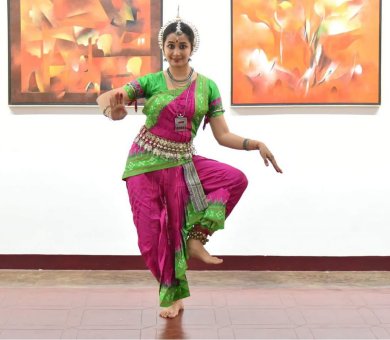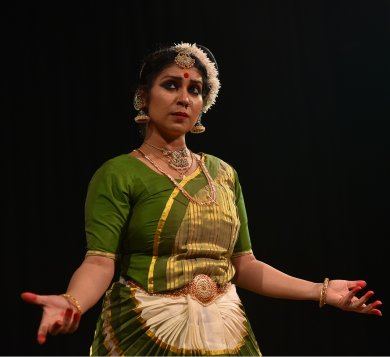
|   |

|   |
Taking classical dance to the grassroots level - Vijay Shanker e-mail: vijaydance@gmail.com March 9, 2022 Many children and youth are attracted to western dance and lifestyle, hence fail to understand the significance of Indian classical music and dance. In fact, lecture-demonstrations on Indian classical music and dance are the need of the hour; the more you understand and appreciate classical arts, you would be naturally drawn to it. National Centre for Performing Arts (NCPA), as part of the Vistaar series, organised a Zoom session featuring two classical dance styles, Mohiniattam and Odissi, for the students of Barisha Purba Pura High School and Alipore Takshal Boys School, Kolkata, on 26th February. The children enjoyed the session as they tried to dance the basic steps of these dances and were excited to do so.  Dhara Gandhi Dutta The online session commenced with Odissi exponent Dhara Gandhi Dutta explaining as to how Odissi belonged to Orissa and evolved from the tradition of gotipua (boys attired as girls) and maharis (devadasis) in Jagannath temple and demonstrated the four basic body positions, mainly pertaining to pada bheda, from the basic sama pada transforming the body to the chauka position, similar to the aramandi in Bharatanatyam. Tribhangis (three bends) and abhangas were also demonstrated. Being a linguist, Dhara cleverly spoke in Bengali, English and Hindi and the children were quite receptive and tried to dance along. She briefly sang the Ganesh Vandana and narrated as to who Ganesha is, the son of Lord Shiva and Parvati, interpreting the Vandana as Lord Ganesha being Ekadanta and Mahakaya seated under the Kalpavriksha. Further, Dhara briefly showed the hasta mudras; for instance the Pataka has multiple usages - when joined together becomes Anjali and with single hand can be used to welcome or say 'don't do that' or when lifted up can be used to scare kids too.  Mythili Anoop Mohiniattam exponent Mythili Anoop explained as to how Mohiniattam originated from Kerala and demonstrated the slow and graceful swaying movements (tham thaka dhimi) which are symbolic of the sway of coconut trees. Mythili explained in Hindi that the technique can be divided into three different movements - arcs, semi circle and circular - hence Mohiniattam is slow with flowing movements and the dancer cannot stop suddenly unlike Kathak wherein the dancer can stop suddenly. Using the Pataka hasta, Mythili demonstrated the slow and radiant rising of the sun; the fluttering of the bees in the lotus was demonstrated with brilliant netra abhinaya creating a lasting impression in her brief presentation. Mythili also explained an item of invocation of the goddess, her attributes of arch like eyebrows and eyes like the fish, with hasta mudras. Lastly, both Dhara and Mythili joined together as they demonstrated nature, the elephant, trees, deer, birds, peacock etc as they entered the forest. Mohiniattam follows Hasta Lakshana Deepika for hasta mudras, hence the hastas used by Mythili were a little different, compared to hastas in Abhinaya Darpana. Both Dhara and Mythili are professional dancers and teachers as well. Dhara is the disciple of accomplished exponent Daksha Mashruwala and Mythili is the disciple of Kalamandalam Kshemavathy and Gopika Varma. It was quite an enjoyable session indeed.  Vijay Shankar is a Kuchipudi and Kathakali exponent, teacher, bilingual journalist, arts critic and actor. |